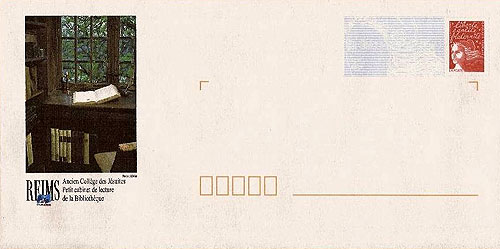The Jesuit College Chapel, Alençon
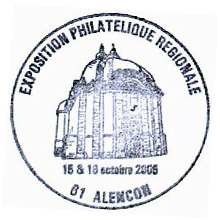

FRANCE, 2005, 2007, cancels showing the chapel
of the Jesuit college in Alençon,
the second ironically a commemoration of Charles Baudelaire's Fleurs du
mal
The Municipal Library of Alençon in the Rue du Collège was built during the 17th century as a chapel for the Jesuit college with interior paneling from Val Dieu Abbey and crowned by a hexagonal bell-tower observatory. Today it protects a treasure trove of 717 manuscripts, including 125 from the Middle Ages, some incunabula and approximately 40,000 books and manuscripts dating from 1500 to 1920. This is the greatest collection of written works anywhere in Basse-Normandie. The school building, in which de la Salle once taught during his formation as a Jesuit, is now the Musée des Beaux-Arts et de la Dentelle (Museum of Lace and Fine Arts).
The College and Chapel, Cambrai
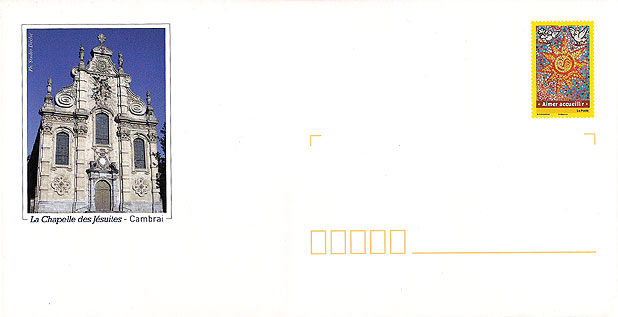
FRANCE, prêt-à-poster (pre-stamped
postal stationery) showing the Jesuits' chapel at Cambrai.
Jesuits came to Cambrai in 1561 at the request of Maximilien de Berghes, first archbishop of Cambrai. They opened a college there on May 8, 1563, and between 1574 and 1575 built a small Gothic church, dedicated on Easter Sunday 1575 to Saint-Michael the Archangel. A century later, the church was proving too small. Archbishop van der Burch (1616-1644) had left money in his will for a new church, though the work only began on June 11, 1679, with Br. Jean Bégrand, SJ as the architect. This Baroque church was complete in 1694. The Jesuits worked at the college and church until they were expelled on April 1, 1765 by an act of Parliament.
Secular clergy took over the college from 1766 until 1793, when the buildings were requisitioned for billeting troops, the revolutionary tribunal installed itself in the college, and the church was used first as a prison, and later as a store house. Between 1836 and 1905 the property reverted to the church and became a major seminary. But after the 1905 law of separation of Church and State, the buildings were transformed into barracks, and during the First World War the church was used as a cinema. Then, from 1918 to 1931, they were returned once again to religious use. The Jesuit chapel was classified as an historic site under various headings beginning in 1920, and in 1958 became a museum of religious art.
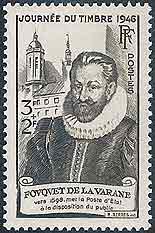
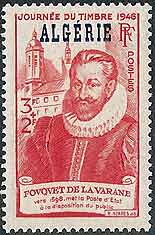
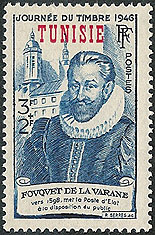
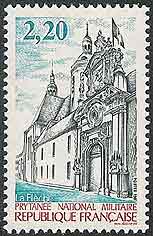
FRANCE, 1946, Scott B206, ALGERIA, 1946,
Scott B46, and TUNISIA, 1946, Scott B90
FRANCE,1987, La Flèche National Military School, Scott 2047
The Collège Royale at La Flèche, a Jesuit college, appears on several stamps honoring Guillaume Fourquet, Governor of La Flèche who gave the King Henry IV the idea of establishing a Jesuit college there. It was originally called the Collège Henri IV. Today it houses a veterans' home. Rene Descartes said of this, his alma mater, "This is where was planted the first seeds of all my later accomplishments and for which I am eternally grateful to the Society of Jesus." The church, visible in the vignette, holds the ashes of the hearts of Henry IV and the Queen Marie de Mèdici.
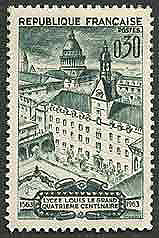
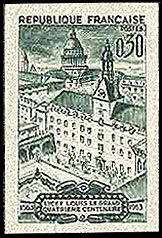
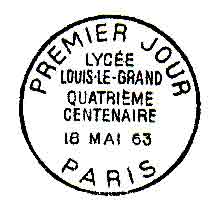
FRANCE, 1963, 4th centenary of Lycée
Louis-le-Grand, Scott 1065, and its FDI cancel
For two centuries the Lycée Louis-le-Grand in Paris had been under the Jesuits, first as the Collège Clermont and then as Collège Louis-le-Grand in gratitude to the king for endowing it. Students came here from all levels of Society, including St. Francis de Sales, Molière and Voltaire. While Voltaire turned out to be an inveterate opponent of the Catholic Church, he felt deep gratitude to the end of his days to the Jesuits who had educated him at Louis le Grand from 1704-1711. This is what he said about them: "I was educated for seven years by men who took unrewarded and indefatigable pains to form the minds and morals of youth. Is it credible that anyone should fail to have some feeling of gratitude toward such teachers."
1998, meter stamp from the Jesuit secondary school, Saint-Louis-de-Gonzague, 12 Rue Benjamin Franklin, Paris
FRANCE, postal stationery (prêts-à-poste, N° 889 Lot 246/169) showing a small library reading room of the collegeThe Jesuits set up their college at Reims in 1606 and asked to be incorporated in the university; in 1609 they obtained their request, but repeated conflicts arose between them and the university on the question of Jansenism, from 1617 until 1752. A Benedictine monastery built in the 12th century was purchased by the Jesuits in 1616 and enlarged and modified by them between 1617 and 1678 to the form we see today. When the order was suppressed in 1762, the complex was turned into a hospital. Today this collection of 17th-century buildings includes a remarkable library and a refectory decorated with woodwork and paintings by Jean Hélart depicting the lives of Saint Ignatius Loyola and Saint Francis Xavier. The books in the library, however, are false and remain from the filming of La Reine Margot for which they were made. The Old College is now home to the Atelier du Patrimoine, the Regional Contemporary Art Funds (FRAC) of Champagne-Ardenne, a planetarium, and, since 2010, the Euro-American Sciences Po Campus. The building also contains a collection of furniture, sculpture and painting. The missionary-explorer Jacques Marquette was one of the alumni of the college before he entered the Jesuits in 1654.

